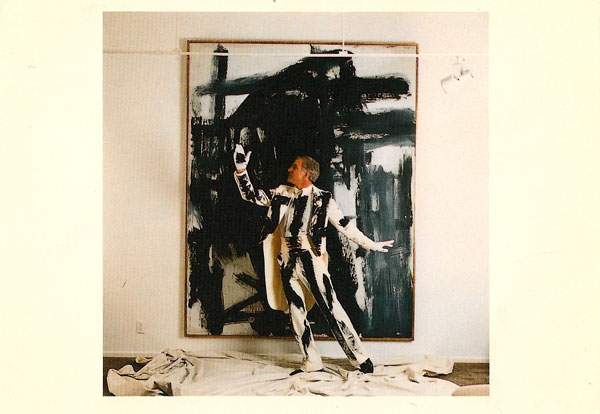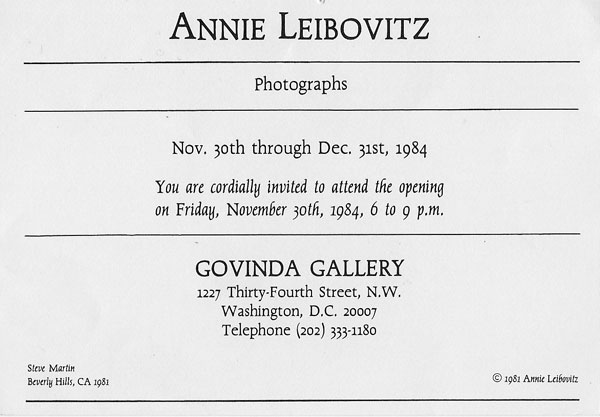Washington Post 1984 Review of Annie Leibovitz’s First Show at Govinda Gallery


Govinda Gallery’s invitation for Annie Leibovitz’s Photographs exhibition. This was Leibovitz’s first exhibition of her photography. The review in the Washington Post is written by the newspaper’s esteemed art critic Paul Richard. Copyright © Govinda Gallery Archives. All rights reserved.
The Washington Post, Tuesday, December 4, 1984
Her Picture Show: Sharp Focus on the Famous
By Paul Richard, Washington Post Staff Writer
Annie Leibovitz’s photographs surprise.
That’s the most surprising thing about them.
The 54 on view at the Govinda Gallery, 1227 34th St. NW, have the sock-it-to-the viewer unsubtlety of posters. Who needs another portrait of the Rolling Stones? Or another of Clint Eastwood, John Belushi, Robert Redford, Woody Allen, Jerry Lewis, Dolly Parton, Bob Dylan, or Bruce Springsteen?
Every face she sells us has already sold.
And yet we buy them without question.
There is, to use an antique word, something hip about these pictures. Leibovitz, the artist, is hip to what is going on. So, too, are the famous folks she shoots. Her photographs make us hip. We’re all in it together. The ‘60s are long past. But some old and warming sense of tribe glows within these portraits, and dissolves the cold commercial gelatin which usually encases American celebrities who pose for magazines.
Here is Robert Redford in the sun at Malibu, posing on the porch of a zillion-dollar beach house. He’s wearing cowboy boots, pressed jeans and his Foster Grants. He is dressed not up, but down. Some duller, lesser artist might have made Redford earnest, might have posed him by a Utah stream, concerned about the trout. Not Leibovitz. The Hollywood book on Redford is he’s nothing but a beach boy: throw a stone at Malibu, and you’ll hit five Robert Redfords, they say. Leibovitz knows that. So does Redford. Looking at this portrait, so do we.
Here, too, is Clint Eastwood, bound around with ropes, standing on some dusty street in the Wild Wild West. He’s wearing his jogging shoes and an alligator shirt.
“I wanted to shoot Eastwood at home,” says Leibovitz. “but he was having trouble with his wife. He said he’d pose on the lot at Burbank, and that I could use any prop around. I got into it. I made the guys who ran the smoke machine change the color of the dust. Just as I was shooting, a grip walked by, carrying a rope. I used it.”
The viewer, Leibovitz and Eastwood, the three of us together, know that the muscular, unkillable Man with No Name is about to burst free.
When Leibovitz, after hanging out at his house, asked Steve Martin how he’d like to be photographed, the comic pointed at his precious abstract by expressionist Franz Kline and said he would like to be seen in that big black-and-white action painting. Leibovitz obliged, sort of. She dressed him in a rented (soon to be ruined) set of white tails which she slathered with black paint.
“I think of myself as having a pretty average viewpoint,” says Leibovitz. “Wrapping Christo or painting the Blues Brothers blue, that’s pretty obvious.”
She is being modest. Her modesty becomes her. It is one of her sharpest weapons. She presents to strangers, and to her subjects, too, a touching vulnerability. Leibovitz is six feet tall—but at the same time she is “Annie,” like the little orphan, a waif in need of help. Strangers let their guards down. They try to help her out.
Sometimes, they betray themselves while doing so—or at least reveal their souls. Her Johnny Carson is a sort of cipher, her John Irving (wearing his wrestling uniform and sucking in his gut) is a caricature of macho, and her John Belushi is a bloated ruin. But Leibovitz, unlike Diane Arbus, say, is rarely harsh. She makes sexy ladies sexy (she portrayed Linda Ronstadt rolling in the sheets and a half-naked Debra Winger necking with her dog); she makes leading men good-looking. Leibovitz, after all, photographs the stars.
Like other busy portraitists, she has some trademark tricks. She likes the privacy suggested by the tiled walls of bathrooms. Or places that look like bathrooms. She photographed Bruce Springsteen, just after a concert, in his white-tiled shower room, Laurie Anderson at a tiled swimming pool, and Woody Allen in the ladies’ room. The tiles there are pink.
The bathroom is an intimate place. Getting naked or even half-naked is an intimate act. Those who pose for Leibovitz –not only Lennon, but Michael Douglas, Mick Jagger, Sylvester Stallone, Jerzy Kosinski (whose chest, she notes, “is wholly hairless”), Lauren Hutton and even Robert Penn Warren—often take their clothes off.
Sometimes she submerges the people whom she photographs. She submerged Lauren Hutton up to her eyebrows in mud, Whoopi Goldberg in milk, and Bette “The Rose” Midler in a sea of red long-stemmed roses.
A young Muhammad Ali, dressed in black and scowling, sprawls on the crimson carpet of his Scarlett O’Hara-scarlet stairs. Rodney Dangerfield hugs a weeping baby. Leibovitz is fine at dreaming up story-telling portraits.
But she invents less than she reports.
She’s an ace journalist. She has that killer instinct for exactly the right instant. Some of the most astonishing pictures she made for Rolling Stone were taken at the White House the day President Nixon, who had just resigned, departed for California. She was competing head-to-head with an army of news photographers. She beat her competition cold. The magazine had commissioned a Nixon-resigns story from Hunter S. Thompson who, not for the first time, blew the assignment. Leibovitz didn’t.
Copyright © The Washington Post. All rights reserved.